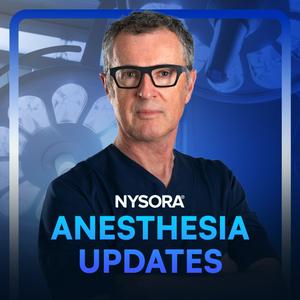67 episódios

The Cannabis Paradox: Worse Pain After Surgery
15/12/2025 | 6min
This episode discusses the main findings of a new study from Sajdeya et al., 2025, published in Regional Anesthesia & Pain Medicine. The research asks a timely, important question: Does cannabis use affect postoperative pain in older adults? We've seen rising cannabis use among seniors, up to 5% nationally, but almost no data on how it affects acute surgical pain. This study finally gives us real evidence, using advanced NLP to detect cannabis use in the electronic record. And the findings? Well... they challenge a lot of assumptions.Where else to find us: Web- http://www.nysora.com Instagram- instagram.com/nysora.inc/ LinkedIN- linkedin.com/company/nysora-inc/ Facebook- facebook.com/nysora Twitter- x.com/nysora TikTok- tiktok.com/@nysora_inc --------------------------------------------------------- #nysora #regionalanesthesia #anesthesiaDisclaimer: Medicine is an ever-changing science. As new research and clinical experience broaden, changes in treatment and drug therapy are required. The authors and publishers have checked with sources believed to be reliable in efforts to provide accurate information within the available or accepted standards of care. However, given the possibility of human error or changes in medical practice, neither the authors nor the publisher, nor any other party involved in the preparation of this platform warrants that the information contained herein is in every aspect accurate or complete, and they disclaim all responsibility for any errors or omissions for the results obtained from the use of the information contained in this work. Readers are advised to confirm the information contained herein with other sources. For example, readers are advised to check the product information of each drug mentioned, and that any information contained on NYSORA's Podcast is accurate.

Rethinking DOACs for Neuraxial & Deep Blocks
08/12/2025 | 7min
This episode discusses the main findings from a 2025 review by Suleiman et al. published in BJA, examining how we should manage direct oral anticoagulants (DOACs) in patients having neuraxial anesthesia and deep peripheral nerve blocks. Traditionally, the ASRA guidelines have leaned heavily on long DOAC interruption times and selective drug level testing to avoid the rare but devastating complication of spinal epidural hematoma. But new evidence—from the PAUSE strategy and the PAUSE-2 pilot trial—suggests that shorter, pharmacokinetics-based DOAC holds may offer comparable safety without increasing thromboembolic risk.Where else to find us: Web- http://www.nysora.com Instagram- instagram.com/nysora.inc/ LinkedIN- linkedin.com/company/nysora-inc/ Facebook- facebook.com/nysora Twitter- x.com/nysora TikTok- tiktok.com/@nysora_inc --------------------------------------------------------- #nysora #regionalanesthesia #anesthesiaDisclaimer: Medicine is an ever-changing science. As new research and clinical experience broaden, changes in treatment and drug therapy are required. The authors and publishers have checked with sources believed to be reliable in efforts to provide accurate information within the available or accepted standards of care. However, given the possibility of human error or changes in medical practice, neither the authors nor the publisher, nor any other party involved in the preparation of this platform warrants that the information contained herein is in every aspect accurate or complete, and they disclaim all responsibility for any errors or omissions for the results obtained from the use of the information contained in this work. Readers are advised to confirm the information contained herein with other sources. For example, readers are advised to check the product information of each drug mentioned, and that any information contained on NYSORA's Podcast is accurate.

Hemodialysis on the table: Rethinking the Risks
01/12/2025 | 8min
In this episode of Updates in Anesthesiology, we discuss a 2025 Anesthesiology Clinical Focus Review on the perioperative management of patients receiving maintenance hemodialysis. This review reshapes how we assess, prepare, and manage a rapidly growing surgical population at exceptionally high perioperative risk. From hidden cardiovascular disease and fluid shifts to electrolyte traps, medication pitfalls, vascular access, and timing of dialysis.Where else to find us: Web- http://www.nysora.com Instagram- instagram.com/nysora.inc/ LinkedIN- linkedin.com/company/nysora-inc/ Facebook- facebook.com/nysora Twitter- x.com/nysora TikTok- tiktok.com/@nysora_inc --------------------------------------------------------- #nysora #regionalanesthesia #anesthesiaDisclaimer: Medicine is an ever-changing science. As new research and clinical experience broaden, changes in treatment and drug therapy are required. The authors and publishers have checked with sources believed to be reliable in efforts to provide accurate information within the available or accepted standards of care. However, given the possibility of human error or changes in medical practice, neither the authors nor the publisher, nor any other party involved in the preparation of this platform warrants that the information contained herein is in every aspect accurate or complete, and they disclaim all responsibility for any errors or omissions for the results obtained from the use of the information contained in this work. Readers are advised to confirm the information contained herein with other sources. For example, readers are advised to check the product information of each drug mentioned, and that any information contained on NYSORA's Podcast is accurate.

Rethinking Unanticipated Difficult Intubation
24/11/2025 | 9min
In this episode of Updates in Anesthesiology, we discuss one of the most significant airway guideline updates in a decade. The Difficult Airway Society’s 2025 guidelines reshape how we approach unanticipated difficult tracheal intubation in adults. From first-attempt success and videolaryngoscopy for all, to peroxygenation, physiologically difficult airways, linear algorithms, and a renewed emphasis on human factors. Where else to find us: Web- http://www.nysora.com Instagram- instagram.com/nysora.inc/ LinkedIN- linkedin.com/company/nysora-inc/ Facebook- facebook.com/nysora Twitter- x.com/nysora TikTok- tiktok.com/@nysora_inc --------------------------------------------------------- #nysora #regionalanesthesia #anesthesiaDisclaimer: Medicine is an ever-changing science. As new research and clinical experience broaden, changes in treatment and drug therapy are required. The authors and publishers have checked with sources believed to be reliable in efforts to provide accurate information within the available or accepted standards of care. However, given the possibility of human error or changes in medical practice, neither the authors nor the publisher, nor any other party involved in the preparation of this platform warrants that the information contained herein is in every aspect accurate or complete, and they disclaim all responsibility for any errors or omissions for the results obtained from the use of the information contained in this work. Readers are advised to confirm the information contained herein with other sources. For example, readers are advised to check the product information of each drug mentioned, and that any information contained on NYSORA's Podcast is accurate.

No Tube, No Problem: High-Flow Nasal Oxygen in General Anesthesia
17/11/2025 | 7min
In this episode of Updates in Anesthesiology, Dr. Hadzic discusses a 2025 Anesthesia & Analgesia trial that challenges a long-standing airway management routine.Could high-flow nasal oxygen (HFNO) replace the laryngeal mask airway (LMA) for short general anesthesia cases without muscle paralysis? This randomized trial puts it to the test, reporting surprising results on safety, comfort, and carbon dioxide dynamics. Stick around as we unpack the science, the caveats, and what this could mean for the future of low-invasive airway management.Where else to find us: Web- http://www.nysora.com Instagram- instagram.com/nysora.inc/ LinkedIN- linkedin.com/company/nysora-inc/ Facebook- facebook.com/nysora Twitter- x.com/nysora TikTok- tiktok.com/@nysora_inc --------------------------------------------------------- #nysora #regionalanesthesia #anesthesiaDisclaimer: Medicine is an ever-changing science. As new research and clinical experience broaden, changes in treatment and drug therapy are required. The authors and publishers have checked with sources believed to be reliable in efforts to provide accurate information within the available or accepted standards of care. However, given the possibility of human error or changes in medical practice, neither the authors nor the publisher, nor any other party involved in the preparation of this platform warrants that the information contained herein is in every aspect accurate or complete, and they disclaim all responsibility for any errors or omissions for the results obtained from the use of the information contained in this work. Readers are advised to confirm the information contained herein with other sources. For example, readers are advised to check the product information of each drug mentioned, and that any information contained on NYSORA's Podcast is accurate.
Mais podcasts de Saúde e fitness
Podcasts em tendência em Saúde e fitness
Sobre Anesthesia Updates
Ouve Anesthesia Updates, Huberman Lab e muitos outros podcasts de todo o mundo com a aplicação radio.pt

Obtenha a aplicação gratuita radio.pt
- Guardar rádios e podcasts favoritos
- Transmissão via Wi-Fi ou Bluetooth
- Carplay & Android Audo compatìvel
- E ainda mais funções
Obtenha a aplicação gratuita radio.pt
- Guardar rádios e podcasts favoritos
- Transmissão via Wi-Fi ou Bluetooth
- Carplay & Android Audo compatìvel
- E ainda mais funções


Anesthesia Updates
descarregue a aplicação,
ouça.


























